

Separate Is Not Equal - Brown v. Board of Education. Veterans of the Civil Rights Movement. Brown v Board of Education (May)Massive Resistance" to integrationWhite Citizens Council Formed (July) Murder Trial of Ruby McCollum (Oct) Citizenship Schools (1954-196?)

Brown v Board of Education Decision (May) See NAACP Builds the Case for preceding events. Back in 1951, the NAACP and local parents and community groups began filing lawsuits against school segregation in various parts of the country as described in NAACP Builds the Case. Background Overview & Summary. The United States Constitution guarantees its inhabitants liberty and equal opportunity.
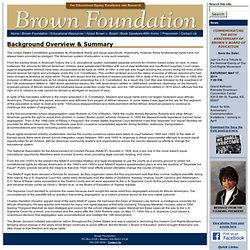
Historically, however, these fundamental rights have not always been provided as pledged. The American system of education is one such example. From the earliest times in American history, the U.S. educational system mandated separate schools for children based solely on race. In many instances, the schools for African American children were substandard facilities with out-of-date textbooks and insufficient supplies. Court cases against segregated schools have been documented as far back as 1849. Brown v. Board of Education. "In these days, it is doubtful that any child may reasonably be expected to succeed in life if he is denied the opportunity of an education.
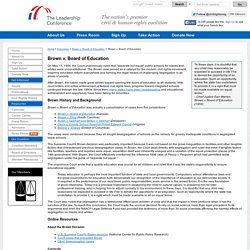
Such an opportunity, where the state has undertaken to provide it, is a right that must be made available on equal terms. "- Chief Justice Earl Warren, Brown v. Board of Education (1954) On May 17, 1954, the Court unanimously ruled that "separate but equal" public schools for blacks and whites were unconstitutional. Brown v. Board of Education – Case Brief Summary. History of Brown v. Board of Education. The Plessy Decision Although the Declaration of Independence stated that "All men are created equal," due to the institution of slavery, this statement was not to be grounded in law in the United States until after the Civil War (and, arguably, not completely fulfilled for many years thereafter).

In 1865, the Thirteenth Amendment was ratified and finally put an end to slavery. Moreover, the Fourteenth Amendment (1868) strengthened the legal rights of newly freed slaves by stating, among other things, that no state shall deprive anyone of either "due process of law" or of the "equal protection of the law. " Finally, the Fifteenth Amendment (1870) further strengthened the legal rights of newly freed slaves by prohibiting states from denying anyone the right to vote due to race.
Brown v Board of Education Summary - Brown v Board of Education 1954. Overview: One of the most historical court cases especially in terms of education was Brown v Board of Education of Topeka, 347 U.S. 483 (1954).
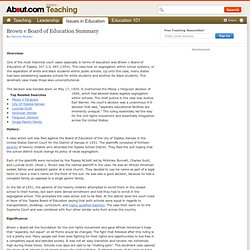
This case took on segregation within school systems, or the separation of white and black students within public schools. Up until this case, many states had laws establishing separate schools for white students and another for black students. This landmark case made those laws unconstitutional. The decision was handed down on May 17, 1954. History: Civil Rights: Brown v. Board of Education I (1954)
Early Civil Rights Struggles: Brown v. Board of Education. [Previous Topic] [Next Topic] [Up] [Table of Contents] [Citation Guide] [Feedback] [Search] [Home] [Help!]
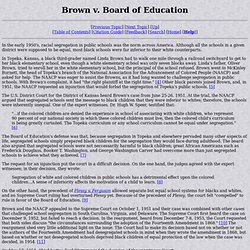
In the early 1950's, racial segregation in public schools was the norm across America. Although all the schools in a given district were supposed to be equal, most black schools were far inferior to their white counterparts. In Topeka, Kansas, a black third-grader named Linda Brown had to walk one mile through a railroad switchyard to get to her black elementary school, even though a white elementary school was only seven blocks away. Brown v. Board of Education. Educational segregation in the US prior to Brown §Background For much of the sixty years preceding the Brown case, race relations in the U.S. had been dominated by racial segregation.
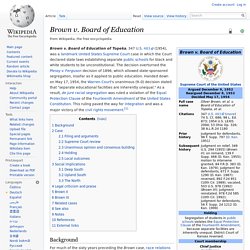
This policy had been endorsed in 1896 by the United States Supreme Court case of Plessy v. Ferguson, which held that as long as the separate facilities for the separate races were equal, segregation did not violate the Fourteenth Amendment ("no State shall... deny to any person... the equal protection of the laws. "). The plaintiffs in Brown asserted that this system of racial separation, while masquerading as providing separate but equal treatment of both white and black Americans, instead perpetuated inferior accommodations, services, and treatment for black Americans.
§Case §Filing and arguments. Brown v. Board of Education. As of July 1, 2013 ThinkQuest has been discontinued.

We would like to thank everyone for being a part of the ThinkQuest global community: Students - For your limitless creativity and innovation, which inspires us all. Teachers - For your passion in guiding students on their quest. Partners - For your unwavering support and evangelism. Parents - For supporting the use of technology not only as an instrument of learning, but as a means of creating knowledge. We encourage everyone to continue to “Think, Create and Collaborate,” unleashing the power of technology to teach, share, and inspire.